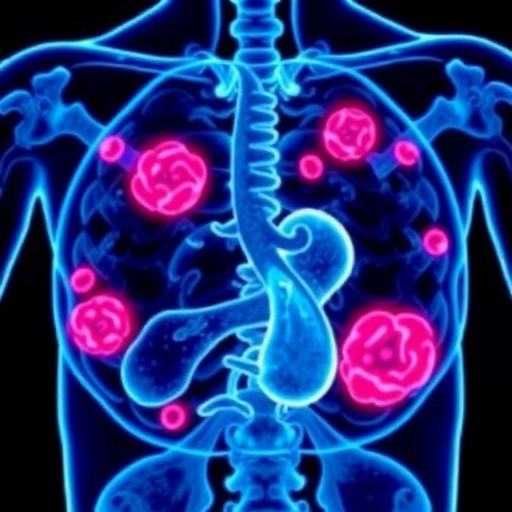In a breakthrough study published recently in BMC Cancer, researchers have unveiled compelling insights into the mutational landscape of HER2/ERBB2-mutated solid tumors and the therapeutic implications of targeting these mutations with HER2-directed treatments. This cutting-edge investigation delves deep into the genomic architecture of refractory solid tumors harboring oncogenic ERBB2 variants, highlighting critical correlations between mutation clonality, treatment response, and the potential of circulating tumor DNA (ctDNA) as a biomarker for monitoring efficacy.
HER2 (human epidermal growth factor receptor 2), encoded by the ERBB2 gene, has long been recognized for its pivotal role in breast and gastroesophageal cancers. Amplifications and overexpression of HER2 protein in these malignancies are well-characterized drivers, serving as prime targets for specific therapeutics. However, ERBB2 oncogenic point mutations, which appear in approximately 3.5% of diverse solid tumors, represent an underexplored frontier that carries promise for expanding targeted treatments beyond traditional HER2-amplified cancers.
The study involved a cohort of nineteen patients with refractory solid tumors carrying deleterious ERBB2 mutations, enrolled under the Copenhagen Prospective Personalized Oncology trial. Despite the variety of primary tumor types and prior treatments, each patient received HER2-targeted therapy tailored to exploit the vulnerabilities unveiled by comprehensive whole-exome sequencing (WES) and longitudinal ctDNA profiling. These genomic techniques allowed researchers to capture the dynamic changes in tumor genetics throughout treatment, providing a sophisticated portrait of evolving mutational landscapes.
.adsslot_sTKc2yNHWq{width:728px !important;height:90px !important;}
@media(max-width:1199px){ .adsslot_sTKc2yNHWq{width:468px !important;height:60px !important;}
}
@media(max-width:767px){ .adsslot_sTKc2yNHWq{width:320px !important;height:50px !important;}
}
ADVERTISEMENT
Importantly, the analysis revealed an overall response rate (ORR) of 37% alongside a disease control rate (DCR) of 68%, and a median progression-free survival (PFS) of 4.4 months. These findings are remarkable given the heavily pretreated, molecularly heterogeneous nature of the cohort. A nuanced observation emerged when dissecting mutation locations within ERBB2: patients harboring oncogenic variants located in the tyrosine kinase domain exhibited a notably higher ORR of 60%, underscoring the therapeutic relevance of mutation topography in dictating drug sensitivity.
Clonality, defined by the proportion of tumor cells carrying a given variant, surfaced as a critical factor governing treatment success. Tumors in which ERBB2 mutations were clonal—present ubiquitously among cancer cells—demonstrated more pronounced responses compared to those with subclonal mutations. This distinction presents a compelling paradigm: targeting clonal driver mutations is far more efficacious, whereas subclonal diversification may contribute to treatment resistance and disease progression.
The study’s innovative use of sequential ctDNA monitoring further solidified the correlation between mutation burden and clinical outcomes. ctDNA, which circulates freely and reflects tumor-derived genetic material, provided a real-time, minimally invasive window into tumor evolution. Variations in ERBB2 mutation allele fractions in plasma mirrored therapeutic response and progression, highlighting ctDNA’s potential as a predictive and monitoring biomarker. As patients responded to therapy, circulating levels of ERBB2 mutations declined, whereas rising levels often heralded imminent resistance.
This temporal layer of molecular surveillance is a leap forward in personalized oncology, since it facilitates proactive treatment adaptations in response to genomic shifts. The integration of ctDNA with tumor tissue sequencing creates a powerful synergy that overcomes limitations inherent in single-timepoint biopsies, offering dynamic insights into tumor heterogeneity and clonal architecture that evolve under therapeutic pressure.
Notwithstanding exciting clinical implications, the researchers were candid about limitations. The small sample size and cohort heterogeneity—reflecting diverse tumor histologies and varied HER2-targeted regimens—necessitate cautious interpretation and underscore the need for larger, more homogeneous clinical trials. Nonetheless, the foundational proof-of-concept established here opens pathways for refining precision medicine approaches tailored to oncogenic ERBB2 variants beyond amplification.
At the molecular level, ERBB2 mutations often activate downstream signaling cascades such as PI3K/AKT and MAPK pathways, driving tumor proliferation and survival. Tyrosine kinase domain mutations, by altering receptor conformation and enhancing kinase activity, sensitize tumors to kinase inhibitors. The observed higher response rate in patients with these specific variants is consistent with mechanistic models predicting direct inhibition of aberrant signaling as a fruitful therapeutic strategy.
Future directions may include the development and clinical evaluation of next-generation HER2 inhibitors optimized to target variant-specific conformations, as well as combination regimens designed to overcome resistance mechanisms arising from tumor heterogeneity. Additionally, applying ctDNA-guided adaptive treatment algorithms in prospective trials could validate the utility of liquid biopsies for real-time therapeutic decision-making.
The study’s rigorous integration of comprehensive genomic profiling, longitudinal ctDNA analysis, and clinical endpoints exemplifies state-of-the-art oncology research. It further cements the concept that understanding mutational clonality and spatial-temporal tumor heterogeneity is critical in realizing the full potential of targeted therapy. As the field moves towards more individualized interventions, dissecting the subtle nuances of ERBB2 mutation biology offers a beacon of hope for patients with otherwise refractory solid tumors.
These findings underscore the imperative of incorporating precise genomic characterization into routine clinical workflows. By identifying patients with clonal HER2/ERBB2 mutations, clinicians can prioritize those most likely to benefit from HER2-targeted agents, mitigating unnecessary exposure to ineffective treatments. The promise of personalized intervention, grounded in molecular realities, continues to reshape cancer therapeutics with ever-increasing precision and efficacy.
In conclusion, this pioneering investigation translates molecular insights into tangible clinical benefits, advocating for expanded molecular testing of ERBB2 mutations in a broad spectrum of solid tumors. The correlation of mutation clonality, domain specificity, and dynamic ctDNA profiles with treatment outcomes paves the way for refined patient stratification and individualized treatment strategies. Despite challenges inherent in rare mutation subsets and tumor heterogeneity, HER2-targeted therapy emerges as a compelling option in this emerging therapeutic niche.
This research exemplifies the evolving paradigm wherein genomics and liquid biopsy converge to revolutionize cancer care. Ongoing studies will undoubtedly build upon these foundations to enhance our understanding of HER2-mutated tumors and optimize therapeutic algorithms. As molecular oncology ventures into previously uncharted territories, the lessons from ERBB2-mutated solid tumors beckon a new era of targeted precision medicine with significant clinical promise.
Subject of Research: Investigation of mutational landscape and therapeutic efficacy in HER2/ERBB2-mutated solid tumors utilizing tumor tissue sequencing and circulating tumor DNA analysis during HER2-targeted therapy.
Article Title: Mutational Landscape Assessed in Tumor Tissue and Circulating Tumor DNA During Treatment of Patients with HER2/ERBB2-Mutated Solid Tumors.
Article References:
Egebjerg, K., Spanggaard, I., Ahlborn, L.B. et al. Mutational Landscape Assessed in Tumor Tissue and Circulating Tumor DNA During Treatment of Patients with HER2/ERBB2-Mutated Solid Tumors. BMC Cancer 25, 1272 (2025). https://doi.org/10.1186/s12885-025-14599-7
Image Credits: Scienmag.com
DOI: https://doi.org/10.1186/s12885-025-14599-7
Tags: circulating tumor DNA biomarkerERBB2 gene mutationsgenomic architecture of cancerHER2 cancer treatmentHER2-directed treatmentsmutation clonality and treatment responseoncogenic ERBB2 variantspersonalized oncology trialrefractory solid tumors studysolid tumors mutation trackingtargeted therapy for HER2 mutationswhole exome sequencing in cancer research




